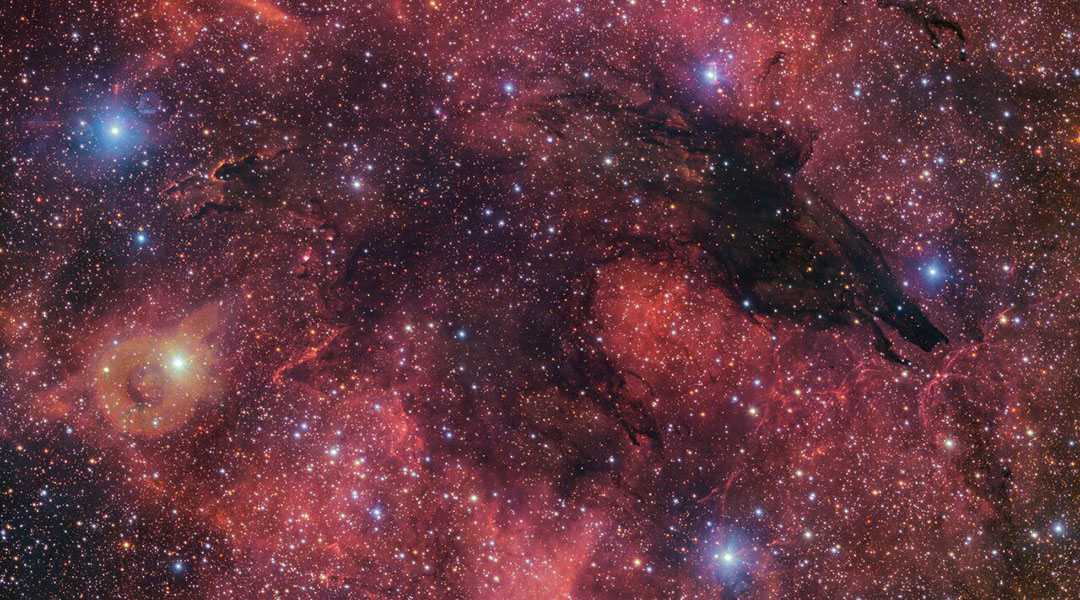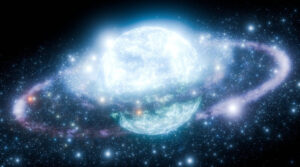This image of a dark nebula creates the illusion of a wolf-like silhouette against a colorful cosmic backdrop.
Just in time for Halloween, the European Southern Observatory (ESO) has released a hauntingly beautiful image of a nebula resembling the shadowy silhouette of a wolf set against a vibrant, star-filled backdrop.
Nicknamed the “Dark Wolf Nebula,” this image is as scientifically intriguing as it is visually striking, offering a look into one of the many enigmatic dark nebulae within our galaxy. Captured by the Very Large Telescope Survey Telescope at the Paranal Observatory in Chile, this detailed, 283-million-pixel image reveals the Dark Wolf Nebula’s intricate structure in stunning detail.
Located within the constellation Scorpius, roughly 5,300 light-years from Earth, the Dark Wolf Nebula is part of a larger nebular structure known as Gum 55. This expansive image covers an area in the sky about four times the size of the full moon, though it represents just a fraction of the immense molecular cloud that houses the Dark Wolf.
With its outstretched form, the nebula resembles a lurking, spectral wolf, lending an eerie seasonal touch to this cosmic portrait.
The nature of dark nebulae
Dark nebulae may look like empty voids, but they’re dense clouds of cold interstellar dust, which block light from stars and other objects positioned behind them, making them appear dark against brighter cosmic backgrounds.
Unlike other nebulae, dark nebulae do not emit visible light; instead, their dust grains absorb and scatter it, particularly in the visible spectrum, preventing them from passing through. This occurs because the size of the dust particles is comparable to the wavelength of visible light, leading to scattering and absorption effects. resulting in the shadowy silhouettes that give them their name.
In contrast, longer wavelengths, such as infrared light, are less affected by these particles due to their longer wavelengths being able to pass through the gaps between dust grains. This property allows astronomers to peer into regions typically obscured by cosmic dust.
Additionally, dark nebulae serve as fertile sites for star formation, providing valuable insights into the early stages of stellar development.
The wolf-like silhouette of this nebula becomes visible against the backdrop of bright hydrogen gas, which glows in reddish hues due to ultraviolet radiation emitted by newly formed stars.
The VLT Survey Telescope
This image was captured by the VLT Survey Telescope, a specialized instrument designed to produce high-resolution images of expansive areas of the southern sky in visible light.
Governed by ESO and situated in Chile’s Atacama Desert, the telescope benefits from some of the world’s clearest skies. Its wide-field capability is ideal for surveys, offering astronomers a detailed view of large-scale cosmic structures, such as the Southern Galactic Plane and Bulge regions.
The survey responsible for this image has cataloged over 500 million celestial objects, using various optical filters to capture distinct sections of the light spectrum. This approach helps astronomers highlight specific features within nebulae, including the Dark Wolf’s ghostly form.
A Halloween treat from the cosmos
As Halloween approaches, the European Southern Observatory’s release of the Dark Wolf Nebula serves as a reminder of the eerie beauty found within the cosmos. The nebula’s shadowy shape, silhouetted against vibrant hydrogen clouds, invites a closer look into the darker, often hidden side of our galaxy’s star-forming regions.
With continued observations from European Southern Observatory projects, who knows what other spectral shapes might be discovered among the stars.
Feature image: A 283-million-pixel image by the VLT Survey Telescope at ESO’s Paranal Observatory in Chile.












+ There are no comments
Add yours